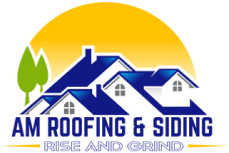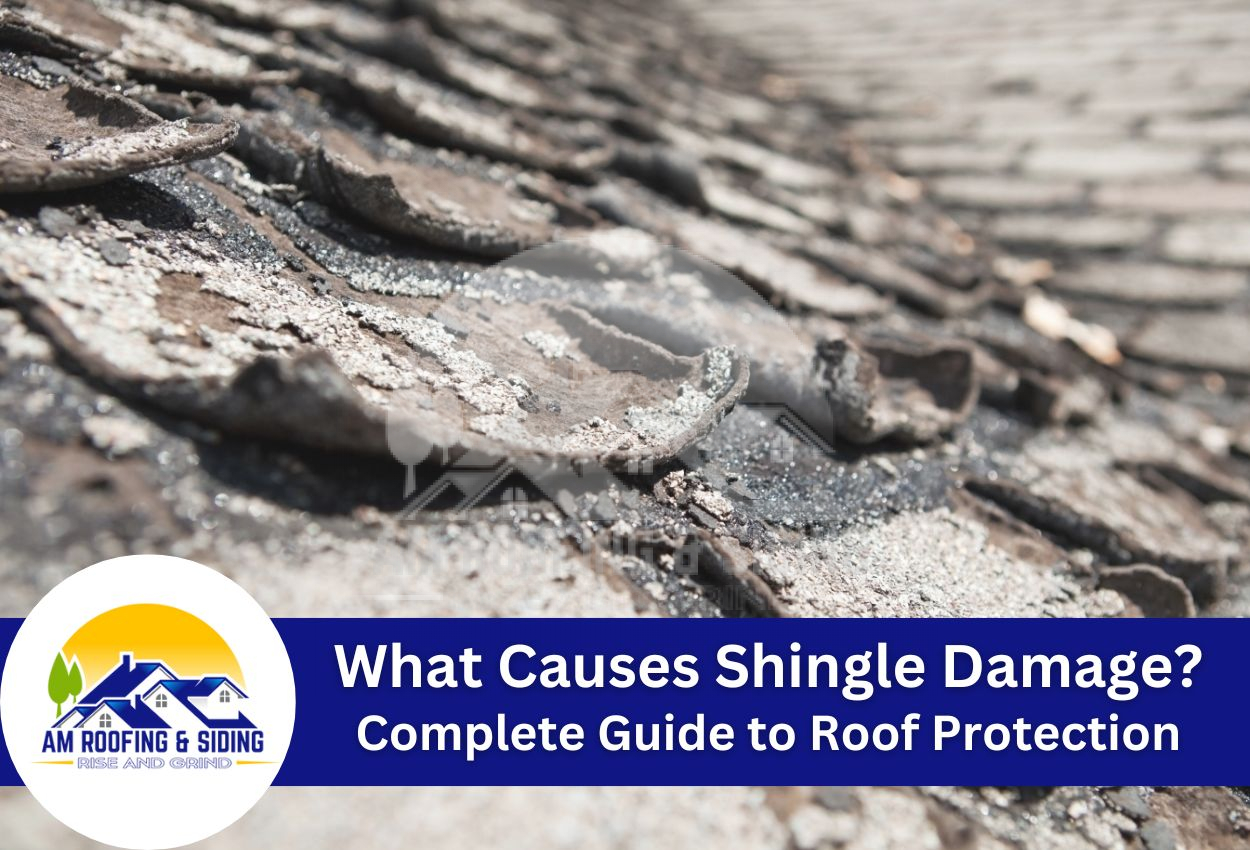Shingle damage represents one of the most common roofing problems facing Central Ohio homeowners. Your roof is your home’s first line of defense against the elements, and damaged shingles can quickly lead to leaks, structural issues, and decreased property value. Knowing what causes shingle damage can be the difference between a simple repair and a complete roof replacement.
Roof shingles face constant exposure to harsh weather that gradually wears down even the most durable materials. From severe storms to subtle manufacturing defects, multiple elements contribute to shingle deterioration over time. The typical asphalt shingle roof should last 15 to 30 years, but without proper awareness of damage causes and regular maintenance, that lifespan can be significantly shortened.
For homeowners, recognizing the early signs of damaged roof shingles allows for immediate intervention before small issues get significantly worse. Curling edges, missing granules, and cracked surfaces all indicate potential underlying issues that require attention. Understanding these causes of shingle damage empowers you to take preventive measures and make better decisions about roof maintenance.
Whether you’re dealing with existing damage or looking to prevent future problems, knowing what affects your roof’s condition is essential for protecting your investment and keeping your home safe for years to come.
Weather-Related Causes of Shingle Damage
Central Ohio experiences a full range of weather conditions that can take a severe toll on roof shingles throughout the year. Hailstorms strike with particular fury, creating impact points that break down the protective granule layer of asphalt shingles and potentially crack the material underneath. Wind damage ranks as another significant threat, with gusts lifting shingle edges and creating entry points for moisture, especially on roofs over 10 years old.
The freeze-thaw cycles common to Ohio winters create additional stress as moisture trapped under shingles expands when frozen, loosening fasteners and creating gaps. Heavy snow accumulation adds excessive weight that can distort and crack shingles, while ice dams force water beneath the roofing materials.
Beyond specific weather events, daily temperature fluctuations cause shingles to repeatedly expand and contract, weakening their structure over time. This thermal shock is particularly damaging during rapid temperature changes. Meanwhile, constant UV exposure from the sun gradually breaks down the asphalt’s chemical composition, drying out the oils and making shingles brittle and vulnerable to cracking.
The combination of these weather-related factors contributes significantly to premature shingle deterioration, making regular inspections essential, especially following major storms. A professional assessment can identify damage before it leads to more serious roofing failure or interior water damage.
Physical Impacts and Environmental Factors
Trees near your home can silently contribute to shingle damage in multiple ways. Overhanging branches physically damage shingle surfaces during windy conditions, gradually wearing away protective granules. When branches fall during storms, they can cause immediate punctures or cracks that compromise your roof’s integrity. Even without direct contact, trees shed leaves, needles, and seeds that accumulate in valleys and gutters, trapping moisture against shingles and accelerating deterioration.
Wildlife also takes a toll on Central Ohio roofs. Squirrels, raccoons, and birds may tear at shingles while seeking shelter or nesting materials, creating entry points for water. Moss and algae thrive in shaded, damp areas of roofs, with root-like structures that gradually penetrate between and under shingles. These organisms retain moisture against the roof surface, speeding decomposition and adding weight that stresses roofing materials.
Environmental pollutants contribute to chemical breakdown as well. Industrial emissions, acid rain, and airborne chemicals settle on roof surfaces and interact with shingle materials. These substances can accelerate the deterioration process by breaking down the asphalt composition. Even bird droppings contain acidic compounds that can damage protective coatings over time.
Regular roof maintenance, including trimming overhanging branches and clearing debris, can significantly extend shingle life by minimizing these physical impacts. Professional inspections can identify biological growth or environmental damage before expensive repairs are needed.
Installation and Manufacturing Issues
Even the highest quality shingles can fail prematurely when installation techniques fall short of industry standards. Improper nailing patterns are among the most common installation errors. When nails are placed too high on the shingle or driven at incorrect angles, they fail to secure the material properly, allowing wind to lift edges and moisture to penetrate. Similarly, not using enough nails per shingle significantly reduces wind resistance, especially in our region’s sometimes turbulent weather conditions.
Inadequate attic ventilation is another critical installation issue. Proper airflow prevents excessive heat and moisture buildup that can literally cook shingles from beneath, causing them to curl, crack, and deteriorate rapidly. Without balanced intake and exhaust vents, trapped heat can reduce shingle lifespan by years.
On the manufacturing side, inconsistencies in asphalt mixture, granule application, or mat saturation can lead to premature shingle damage. Signs of manufacturing defects include blistering, uniformly cracked shingles across the entire roof (rather than in weather-exposed areas), or granule loss in distinctive patterns. These issues often qualify for warranty coverage, though documentation of the damage is essential.
When assessing damaged roof shingles, professional roofers look for tell-tale signs distinguishing installation errors from manufacturing defects. This expertise helps homeowners choose appropriate fixes, whether through contractor corrections or manufacturer warranty claims, preventing further deterioration of the roofing system.
Recognizing Signs of Shingle Damage Before Major Problems Develop
Spotting shingle damage early can save Central Ohio homeowners significant expense and prevent structural issues. From ground level, you can spot several warning signs that indicate potential problems. Inspect for shingles that are curled around the edges or buckled in the middle, which suggests age-related deterioration or excessive heat exposure. Dark, sand-like debris in the gutters or downspouts indicates granule loss, exposing the asphalt mat to damaging UV rays. Also, watch for cracked, broken, or missing shingles, which create vulnerable entry points for water.
Interior indicators can reveal roof problems before they become visible outside. Water stains on ceilings or walls often point to compromised shingles, allowing moisture infiltration. Unexplained increases in energy bills may indicate that damaged shingles are affecting your home’s insulation efficiency. A thorough attic inspection can reveal early warning signs – check for daylight visible through the roof boards, water stains on rafters, or excessive moisture that could indicate shingle failure.
Regular seasonal inspections are especially important after severe weather. Taking photographs during these inspections provides documentation of changes over time. When in doubt about potential damage, professional roofers can assess your home to identify signs of an issue before major structural damage is done.
Preventative Maintenance Strategies for Ohio Homeowners
Taking steps to maintain your roof can extend the life of your shingles and prevent unnecessary damage. For Central Ohio homeowners, having a regular maintenance routine is essential given our region’s changing weather patterns.
A seasonal maintenance approach offers the most comprehensive protection. In spring, inspect for winter damage, remove fallen branches, and check for loose or damaged shingles. Summer maintenance should include looking for signs of sun damage and ensuring proper attic ventilation to prevent heat-related deterioration. Fall requires diligent gutter cleaning and removal of leaves and debris that can trap moisture against shingles. Winter inspections should focus on preventing ice dam formation that forces water under shingles.
Professional inspections complement homeowner maintenance and should be scheduled annually. Certified roofing contractors have the expertise to spot subtle signs of damaged roof shingles that untrained eyes might miss. They can identify early stages of moss growth, inspect flashing integrity, evaluate ventilation systems, and assess overall shingle condition. These professionals also have the safety equipment necessary to thoroughly examine steeper roof sections where weather impact on roof shingles is often most severe.
By combining regular DIY maintenance with professional assessments, Ohio homeowners can identify signs of damage, effectively preventing shingle roof deterioration and avoiding the substantial costs associated with major repairs or premature replacement.
When to Repair vs. Replace Damaged Shingles
Deciding whether to repair or replace damaged shingles requires a careful assessment of several key factors. When damage is isolated to a small area and the shingles are relatively new (less than 10 years old), repairs are often sufficient and cost-effective. Localized issues like a few cracked or missing shingles from a fallen branch can typically be addressed without full replacement. However, when damage covers more than 30% of the roof surface or appears in multiple areas, replacement is typically the more practical long-term solution.
The age of your existing roof plays a critical role in this decision. If your shingles are approaching the end of their expected lifespan (15 to 20 years for standard asphalt shingles in Central Ohio), even minor damage may warrant complete replacement, as repairs would likely be temporary. Similarly, if you notice widespread granule loss, curling edges, or brittleness across your roof, these indicate systemic deterioration that repairs cannot adequately address.
When selecting replacement shingles, Central Ohio homeowners should consider advanced materials designed to withstand our region’s specific challenges. Impact-resistant shingles with Class 4 ratings offer superior protection against hail and falling debris. Look for products with enhanced wind warranties (over 130 mph) and algae-resistant granules that prevent the black streaking common in our humid summers. Many manufacturers now offer warranties specifically addressing weather-related damage common to our region, providing valuable long-term protection for your roofing investment.
Protect Your Home with Expert Shingle Repair from AM Roofing & Siding
Understanding what causes shingle damage is crucial for maintaining your roof over its lifespan. Whether it’s weather impacts, physical damage, or installation issues, recognizing the signs early can save you from expensive fixes down the line. If you’ve noticed any signs of damage or just want to ensure your roof is in good condition, it’s time to call the professionals.
AM Roofing & Siding specializes in diagnosing and addressing shingle damage, ensuring your home stays safe and secure through all seasons. Call us today at (740) 974-8268 to schedule a thorough roof inspection or to discuss repair and replacement options tailored to your needs. Don’t wait — proactive care is the best way to protect your roof and home.

